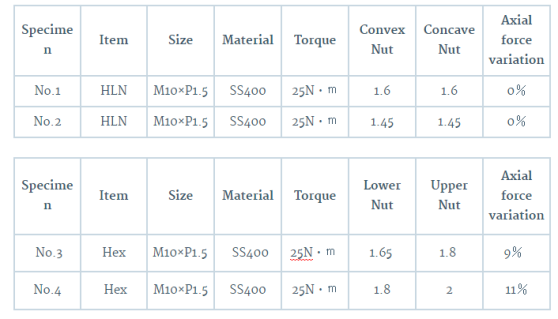The globally recognized HARDLOCK Nut
Utilizing the wedge principle used in ancient Japanese architecture, the HLN is the ultimate self-locking nut which perfectly succeeds to integrate the nuts with the bolt.

■Self-locking effect recognized by the world
HARDLOCK Nut also passed the United States NAS (National Aerospace Standard) aviation standards.
■Enables Torque and Axial Force control
Controlling axial force with proper torque wherever it is used.
■Possible to re-use
All metal with little abrasion, sustains a high self-locking effect.
■Good and simple work ability
Easy installation with commercially available tools.
■Provides substantial cost savings
Allows significant reduction in total cost by reducing maintenance costs, labor costs etc.
Self-locking Design

Self-locking effect recognized by the world
The representative tests which are used to loosen jointed bolts/threaded fasteners by subjecting transverse repeated loadings and impact to the bolt’s axis in perpendicular direction are: the German Industrial Standards: DIN65151 Junker-type screw loosening test Junker Vibration Test), and the National Aerospace Standards: NAS3350 / 3354 test.
1.1 Junker Vibration Test
(Loosening under transverse repeated loading test)

Point 1 : Even with High, Proper or Low axial clamp force, the HARDLOCK NUT will not come loose

Point 2 : Even with 3 different amplitude displacements the HARDLOCK NUT will not come loose
 Click here Other test conditions for loosening under transverse repeated loadings test
Click here Other test conditions for loosening under transverse repeated loadings test
1.2 NAS Test : NAS 3350 / 3354 Test Results
 Click here NAS Test
Click here NAS Test
1.3 Loosening under transverse cyclic loads test data
Click here Loosening under transverse cyclic loads test data
Management of torque and preload
Tightening test results
The basics of how to use the HARDLOCK Nut:
After applying axial force to the Convex Nut, use the Concave Nut to lock them together.
The Convex Nut should be tightened with the same axial force as a general hex nut, the Concave Nut, however, shall be installed with the recommended torque set by HARDLOCK Industry Co., Ltd.
Below you can see the tightening test results of the HARDLOCK Nut and standard double nuts.

Click here Tightening test results
Reusability
One of the features of the HARDLOCK products is that they can be re-used several times.
Performance after repeated usage and information relating to torque and axial force are shown below:
■Test Conditions
Specimens
Bolt: M12×70, Strength Class 4.8, Surface Treatment: Trivalent Chromate
Nut: HLN, Strength Class 4, Surface Treatment: Trivalent Chromate

Junker test result

Impact vibration test complying to NAS 3350 / 3354

We conducted our own original severe vibration impact tests based on the US NAS3350/3354 standard screw looseness test, and verified that all types and sizes of HARDLOCK Nuts exceed this evaluation standard by a clear margin. As self-locking nuts used in civil engineering applications such as railways, highways, bridges, pylons, etc., HARDLOCK Nuts are exposed to a wide range of vibrations and impacts on a continuing basis. However, the data from these tests proves that the HARDLOCK Nuts maintain a stable tightened condition regardless of the type of impact to which they are exposed. A performance comparison with other general-purpose nuts demonstrates the clear superiority of the HARDLOCK Nuts for tasks where vibration resistance is paramount.
Junker Test

A Junker test is a mechanical test to determine the point at which a bolted joint loses its preload when subjected to shear loading caused by transverse vibration. A special feature of the Junker Test is that it can by a variety of condition settings confirm the reduction in the initial axial force (fastening force / preload) with a numerical and graphical representation, due to the ability to reliably quantify, in Europe, it is a common test method for evaluating loosening of threaded fasteners.
Test Condition
Size range: M10 to M16
Amplitude: ±0.25mm to ±1.5mm
Vibration Frequency: 1 to 30Hz
Axial Force: 1 to 80kN
Tensile strength test
| No. | Specimen | Breaking Load |
|---|---|---|
| 1 | General Hexagon Nut | 9,050kg |
| 2 | General Hexagon Nut | 8,950kg |
| 3 | HARDLOCK Nut | 9,800kg |
| 4 | HARDLOCK Nut | 9,800kg |
| SizeM16×P2.0 MaterialSS400 | ||
■Amsler Tensile Test

Torque & Axial Force Test

Unlike the double nut, the HLN enables torque and axial force management, when tightening the Concave Nut (Locking Nut) there is no rise in the bolts axial force
※ However, when the gap between the HARDLOCK Convex Nut and Concave Nut is completely eliminated, a slight rise in axial force can occur, so please be advised not to over tighten the Concave Nut (Locking Nut)

Function effect Test
“Loosening the Concave Nut a little by little from a specified torque condition”
No matter the circumstances the HARDLOCK Nut will maintain a complete tightened condition, however, on the basis of the assumption “what if it is not tightened to complete contact during the installation procedures”, we turned the HARDLOCK Nut M12 back 45 °, yet more than half of the torque remained. Furthermore, we conducted a vibration test in this state, and no loosening occurred.
This shows that even if you do not tighten the HARDLOCK Nut to complete contact, the
HARDLOCK Nut still provides more than sufficient self-locking effect.
This really shows the underlying of the lock energy that is the HARDLOCK Nut.
These results also show that the HARDLOCK Nut will not become loose even if it is not tightened to complete contact.
Total cost comparison (Certain Railway Company)

Precautions
When reusing the HLN or HLB products, first install the Convex Nut (tightening nut), then Install the Concave Nut (Lock Nut) onto the Convex Nut manually by hand until it no longer turns, make sure that the gap between the Convex Nut and the Concave Nut is about 1 thread pitch, if not, refrain from reusing.
When tightening the Concave Nut (Lock nut), hold the Convex nut (Tightening Nut) in position with a spanner to prevent simultaneous rotation.
The HARDLOCK Nut and HARDLOCK Bearing Nut are produced with screw threads of tolerance zone class 6H. If you are using a bolt or shaft which is narrower than the lower limit of 6g, such as 8g, the tolerance between the bolt and nut becomes increased and the Concave Nut (Lock Nut) may come in close contact with a lower torque than our specified torque value. In this case, sufficient self-locking effect will not be achieved, therefore we recommend that you use 6g bolts or shafts that will fit with 6H internal fasteners. If replacement is not possible (such as because a special product is being used), please contact us at Matkem
Because of the thick galvanizing layer that results from hot-dip galvanizing, over-tapped HARDLOCK Nuts are used. Such products may not fit well with products having a thin coating such as produced by electroplating. Please confirm that nuts and bolts have the same surface treatment before use.
Since the HARDLOCK Nuts and HARDLOCK Bearing Nuts are produced with screw threads of tolerance zone class 6H. Therefore, if you use a bolt or shaft with 6g tolerance zone class screw threads there should be no problem, however, if the bolts or shafts have been fabricated in accordance with dimensions from a general hex nut, they might not fit since sometimes general hex nuts deviates from correct standards. If this occurs, please use a ring gauge etc. to confirm the products standards.
The surface treatment process involves variables such as temperature, concentration and immersion time. Depending on the exact mix, there may be some difference in the color of the plating. Regardless, however, this has no effect on the corrosion resistance of the plating.
Parkerizing, also known as phosphating, is used as a foundation for subsequent coatings or paintings and does not provide corrosion resistance on their own because the coating is penetrable. Please be aware that in some environments, a parkerized surface may rust in a week or sooner.
At HARDLOCK, we work day in and day out to make sure the HARDLOCK Nut and other products live up to our customers’ expectations. In our pursuit of perfection, we may change the basic dimensions, engraved dimension tolerances and other specifications. In cases where there is not a large change in functionality, we strive to notify our customers in advance about the minor changes, but due to restrictions on our resources, we recommend checking our website from time to time. We thank you for your understanding.
As HARDLOCK generally applies a special lubricant we have developed to our stainless steel fasteners, no lubricant application should be needed. In addition, the added application of a general lubricant may actually decrease the lubrication of the fastener, so please be careful in this regard. (An exception is our HL Spray, which may be used without loss in lubrication.)








